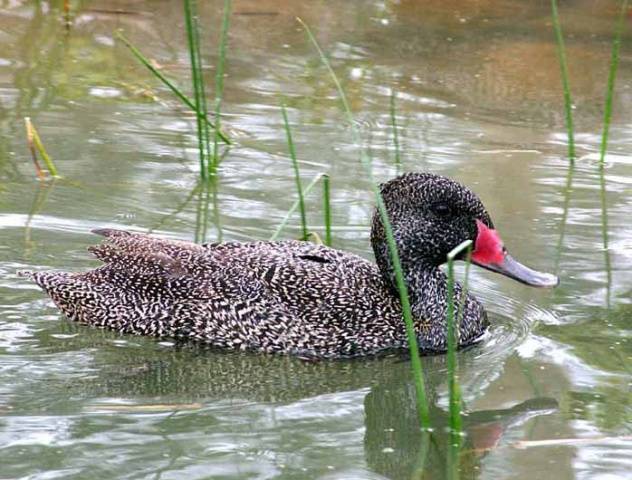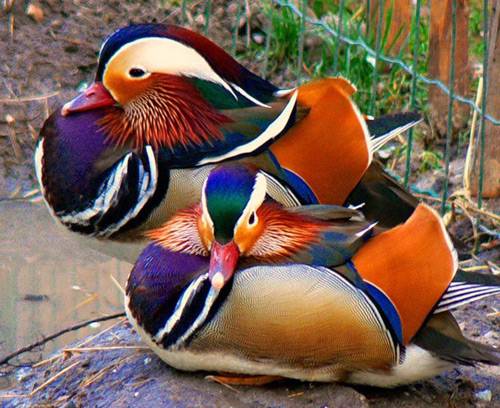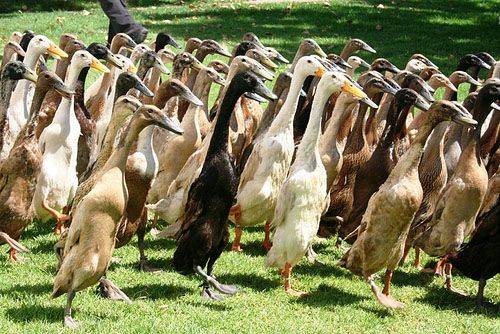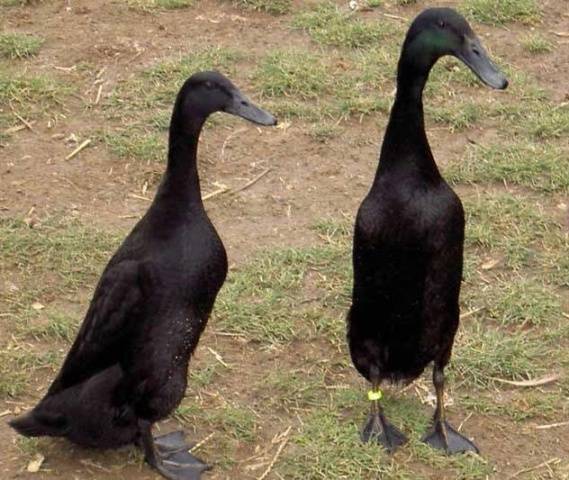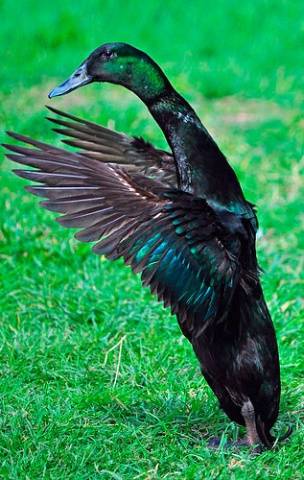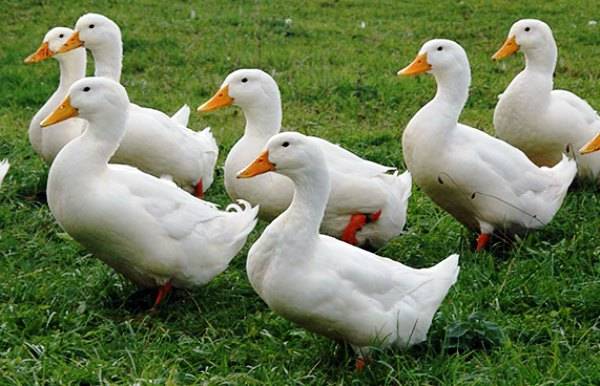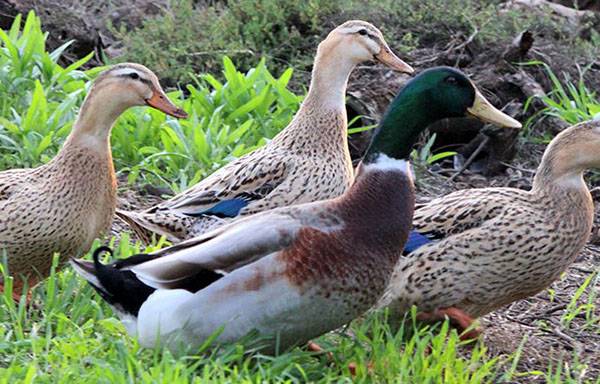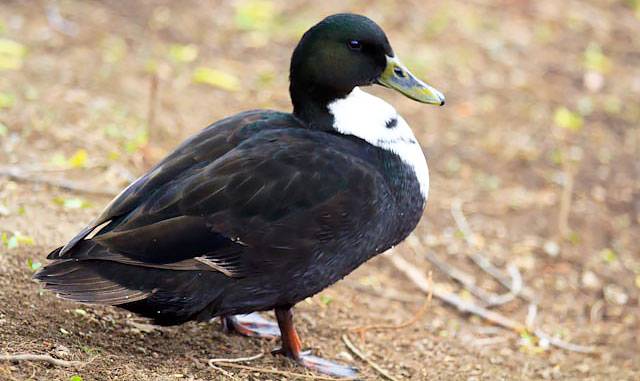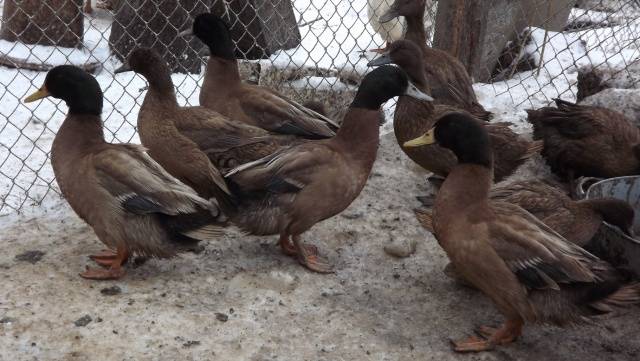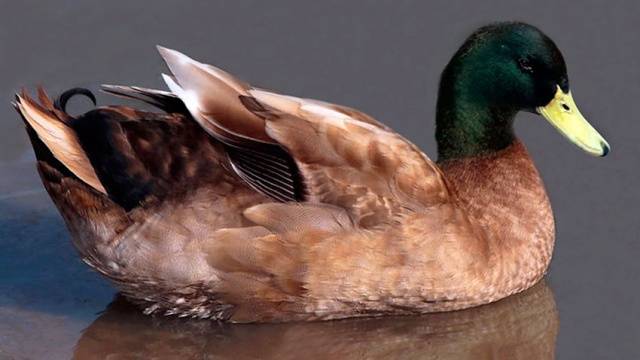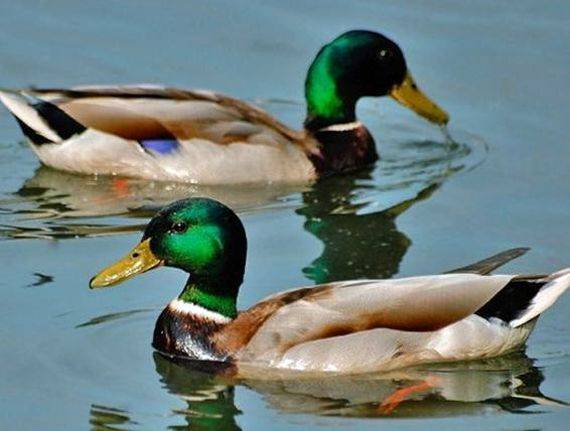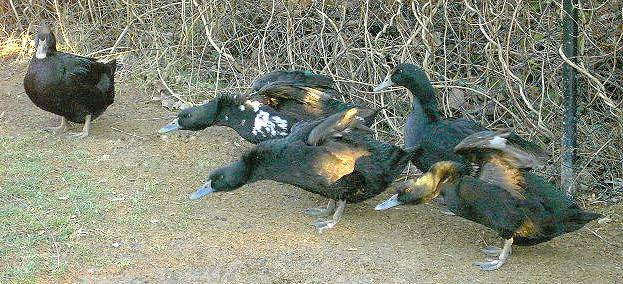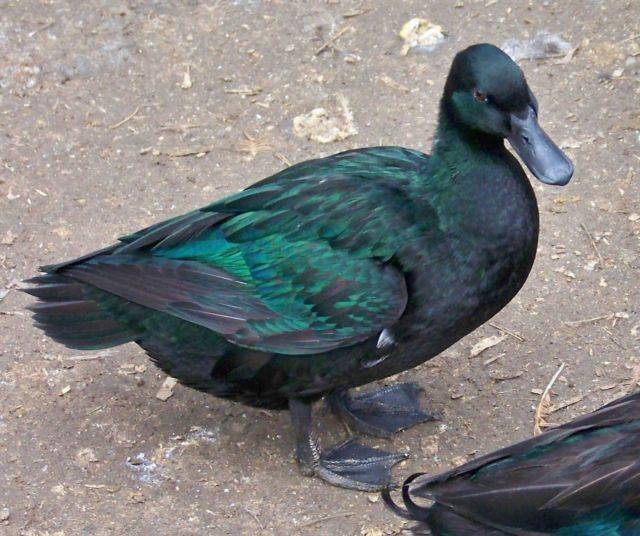Content
In total, there are 110 species of ducks in the world, and 30 of them can be found in Russia. These ducks even belong to different genera, although they are part of the same duck family. Almost all types of ducks are wild and can be found only in zoos or among fans of this family of birds as decorative pets, and not as productive poultry.
Among the ducks, there are real beauties who could become a decoration of a poultry yard.
The speckled duck is very interesting.
Simply luxurious ducks - mandarin duck
But only two types of ducks were domesticated: Muscovy duck in South America and mallard in Eurasia.
Either the Indians did not understand breeding work, or did not consider it necessary to deal with this issue, but the musk duck did not give domestic breeds.
All other breeds of domestic ducks come from the mallard. Due to mutations and selection, domestic thoroughbred ducks still differ from each other, although only slightly.
For some reason, there is a belief that all today's breeds of ducks originate from the Peking duck. Where this opinion came from is completely incomprehensible, since the Peking duck is a clear mutation with a white color that does not exist in the wild mallard. Perhaps the fact is that the Peking duck, being a breed of meat direction, was used to breed new meat breeds of ducks.
In Russia, in contrast to China, the use of duck eggs is not very common. This is largely due to the fact that the chance of contracting salmonellosis through a duck egg is much higher than when eating chicken eggs.
Directions for breeding domestic duck
Duck breeds are divided into three groups: meat, egg-meat / meat-egg and egg.
The egg group includes the minimum number, or rather, the only breed of ducks: the Indian runner.
Native to Southeast Asia, this breed has the most exotic appearance of all mallards. They are sometimes called penguins. This breed is already 2000 years old, but it has not received wide distribution. Even in the USSR, this breed was in insignificant quantity among ducks of other breeds bred on state and collective farms. Today they can be found only in small farms, where they are kept not so much for the sake of production as for the sake of an exotic species.
The suits of the runners are quite diverse. They can be of the usual "wild" color, white, piebald, black, speckled, blue.
These ducks are big water lovers. They cannot live without it, so a mandatory requirement when keeping runners is to have a bath. Interestingly, these ducks even reduce egg production without water. When properly kept, ducks lay an average of 200 eggs. Proper maintenance means not only the presence of a bath, but also unlimited access to food. This is the breed that should not be put on a diet.
The weight of the runners-drakes is 2 kg, of the ducks - 1.75 kg.
Runners tolerate frost well. In summer, when kept on free grazing, they find their own food by eating plants, insects and snails. True, if these ducks penetrate into the garden, you can say goodbye to the harvest.
But, as in all matters, the problem of eating all the vegetation that the runners see has another side. Abroad, these ducks work daily to weed vineyards.Since these ducks are distinguished by tender and tasty meat, the plantation owners solve several problems at once: they do not use herbicides, saving money and producing environmentally friendly products: they get decent harvests of grapes; supply duck meat to the market.
If egg breeds have nothing to choose from for breeding in a private courtyard, then when choosing other directions it would be good to have a description of duck breeds at hand. And, preferably, with a photo.
Meat breeds
Duck meat breeds are the most widespread in the world. And the first place in this group is firmly held by the Peking duck. In the USSR, Peking ducks and crosses with them accounted for 90% of the total meat duck population.
Peking duck
The name "Peking" breed received, naturally, from a city in China. It was in China that this type of domestic duck was bred 300 years ago. Having arrived in Europe at the end of the 19th century, the Peking duck quickly gained recognition as the best meat breed. This is not surprising given the average weight of drakes 4 kg, and 3.7 kg of ducks. But in birds: either meat or eggs. The egg production of the Peking duck is low: 100 - 140 eggs per year.
Another disadvantage of this breed is its white plumage. When it comes to young animals slaughtered for meat, the sex of the ducks does not matter. If you need to leave part of the herd to the tribe, you have to wait until the ducks molt into "adult" plumage with a pair of curved feathers growing on the tails of the drakes. However, there is one secret.
So the hunting stories about how a man went to loud quacking of drakes in the spring should not be believed. Either he lies, or the poacher, or he gets confused.
The females also raise the hubbub, demanding feeding.
Gray Ukrainian duck
The color differs from the wild mallard only in lighter tones, which may be the variability of colors in the local population of mallards, since this breed was bred by crossing local Ukrainian ducks with wild mallards and subsequent long-term selection of desirable individuals.
By weight, the gray Ukrainian duck is not much inferior to the Peking duck. Females weigh 3 kg, drakes - 4. When feeding this breed, no special feed is used. At the same time, ducklings are already gaining a slaughter weight of 2 kg by 2 months. The egg production of this breed is 120 eggs per year.
The gray Ukrainian duck was strictly selected due to its unpretentiousness to feed and keeping conditions. She calmly tolerates frost in unheated poultry houses. The only condition that must be observed is deep bedding.
Ducks of this breed are often fed on free grazing in ponds, driving them to the poultry yard only to give concentrates for lunch. Although, of course, the duck also receives food in the morning before pasture to the pond and in the evening before spending the night.
There are offspring split off as a result of mutations from the gray Ukrainian duck: clay and white Ukrainian ducks. Differences in plumage color.
Bashkir duck
The appearance of the Bashkir ducks breed is an accident. In the process of improving the white Peking duck at the Blagovarsky breeding plant, colored individuals began to appear in the herd of white birds. Most likely, this is not a mutation, but a recurrent manifestation of genes for the color of the wild mallard. This feature has been highlighted and consolidated. As a result, we got a "purebred Peking duck" of color, called Bashkir.
The color of the Bashkir duck resembles a wild mallard, but paler. Drakes are brighter and more like wild ones. The presence of piebald in color is a heritage of white ancestors.
The rest of the Bashkir duck repeats the Peking duck. The same weight as the Peking one, the same growth rate, the same egg production.
Black white-breasted ducks
The breed also belongs to meat. In terms of weight, it is slightly inferior to the Beijing one. Drakes weigh from 3.5 to 4 kg, ducks from 3 to 3.5 kg. Egg production is low: up to 130 eggs per year.The color, as the name implies, is black with a white chest.
The breed was bred at the Ukrainian Institute of Poultry by crossing local black white-breasted ducks with Khaki Campbell ducks. This breed is a genetic reserve. Black white breasts have good reproductive qualities.
The weight of ducklings by the age of slaughter reaches one and a half kilograms.
Moscow White
Breed of meat direction. It was bred in the 40s of the last century in the Ptichnoye state farm near Moscow by crossing Campbell's khaki and Peking duck. Its characteristics are very similar to the Peking duck. Even the weight of drakes and ducks is the same as the Peking breed.
But ducklings in two months weigh a little more than Peking ducklings. Not much, though. The weight of two-month-old Moscow white ducklings is 2.3 kg. The egg production of Moscow white ducks is 130 eggs per year.
Meat and egg breeds of ducks
Egg-meat or meat-egg breeds are of the universal type. They have certain differences in the number of eggs and carcass weight. Some are closer to the meat type, others to the egg type. But, if you want to get both eggs and meat from ducks, then you need to start just universal breeds.
Khaki Campbell
Meat and egg breed of ducks, bred by an Englishwoman for the needs of her family. Adele Campbell set a simple task for herself: to provide a family with ducklings. And along the way, and duck eggs. Therefore, she crossed the pale-piebald Indian penguins with the Rouen duck and added the blood of mallard-dyed mallards. As a result, in 1898, a mallard after bleach duck was presented at the exhibition.
It is unlikely that such a color was to the liking of the visitors of the exhibition, and even in the wake of the fashion for fawn colors. And Mrs. Adele Campbell decided to cross again with the pale-piebald Indian runners to get a fawn color.
"If only everything were so simple," said genetics, then little studied. The ducks turned out to be the color of the uniforms of the soldiers of the English army of those times. After looking at the result, Mrs. Campbell decided that the name "khaki" would suit the ducks. And she could not resist the vain desire to immortalize her name in the name of the breed.
Today, Khaki Campbell ducks have three colors: fawn, dark and white.
They inherited the dark duck from the Rouen duck and this color is most similar to the color of the wild mallard. White in a certain percentage of offspring occurs when piebald individuals are crossed. Further, it can be fixed.
Campbell khakis weigh a little compared to beef breeds. Drakes on average 3 kg, ducks about 2.5 kg. But they have a good egg production: 250 eggs per year. This breed is growing rapidly. Young growth in two months gains about 2 kg of weight. Due to the thin skeleton, the slaughter yield of meat is very decent.
But khaki has one drawback. They are not very responsible for the duties of a brood hen. Therefore, intending to breed Campbell Khaki, at the same time with the ducklings, you will have to buy an incubator and master the incubation of duck eggs.
Mirrored
By color, it is an ordinary mallard, only it lives in the poultry house and is not afraid of people. The name is given by the very blue "mirror" on the wings, characteristic of mallard drakes. The color variability of ducks is much higher than that of drakes. Females can be nearly white.
The breed was bred in the 50s of the 20th century in the Kuchinsky state farm. When breeding, strict requirements were imposed on the future breed. The aim was to obtain hardy poultry with high quality meat and high egg production. The ducks were kept in Spartan conditions, achieving high frost resistance and selecting young animals with high productivity for repair.
As a result, we got a breed of medium weight. Drake weighs from 3 to 3.5 kg, duck - 2.8 - 3 kg. Ducklings gain 2 kg by two months. This breed begins to lay eggs at 5 months and lays up to 130 eggs per year.
It is unpretentious in keeping and often gains weight on free grazing.Perhaps due to its “usual” appearance as a wild mallard, this breed has not gained popularity among breeders and is kept in small numbers on small farms. And, perhaps, poultry farmers are simply afraid that would-be hunters who cannot distinguish moose from cows will shoot all domestic ducks, glad that they do not even try to fly away.
Cayuga
It is difficult to confuse this meat and egg breed of American origin with the wild mallard. Although craftsmen can be found. The second name of this breed is "green duck", since the bulk of the livestock has black plumage with a green tint.
Cayugi easily tolerate a cold climate, behave much quieter than a Peking duck. Able to carry up to 150 eggs per year. The average weight of adult drakes is 3.5 kg, ducks - 3 kg.
It happens. Not only kayugs run out of cartridges.
The kayuga has a well-developed brooding instinct, so they can be used as hens for those breeds of ducks (for example, Khaki Campbell), which do not consider it necessary to sit on eggs.
The kayugs have tasty meat, but they are often grown for decorative purposes, since the carcass of the kayuga does not look very appetizing due to the dark hemp in the skin.
Indoor
The South American species of duck stands apart: musk duck or Indo-duck. This species has no breeds.
The decent weight of an adult drake (up to 7 kg), the large size of the species, "voicelessness": the Indo-duck do not quack, but only hiss - made this type of ducks quite popular among poultry farmers.
Ducks have a well-developed maternal instinct. They can even sit on goose eggs.
The meat of these ducks is low-fat, with high taste, but due to the lack of fat, it is somewhat dry. Also, a plus for this type is the lack of noise.
The downside is potential cannibalism.
Let's summarize
Unfortunately, many duck breeds in the photo without a scale are still impossible to distinguish from each other. You need to know a set of signs in order to determine the breed of a duck. And it's easier to buy ducklings from breeding farms with a guarantee that they will sell you the desired breed.
If ducks are needed for industrial cultivation for meat, you need to take white breeds of meat ducks: Peking or Moscow.
A mirror breed would be good for a private trader for universal use, but it is very similar to a wild duck. Therefore, it is better to take Khaki Campbell.
And for the exotic, you can get a runner, kayugi or find another original looking breed.
